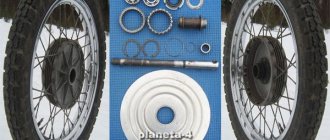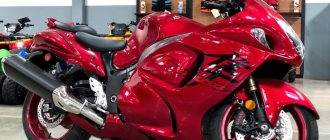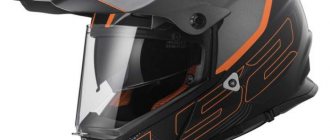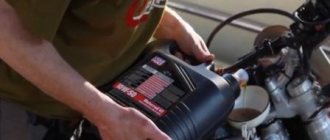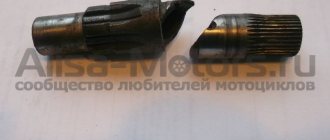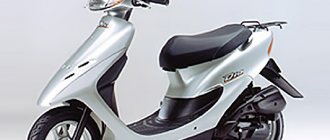“Dnepr” has been produced at the Kiev motorcycle plant since the mid-twentieth century. In Soviet times, it was popular along with Ural technology and was its direct competitor. Now the Irbit plant has stopped producing its motorcycles, but the Kiev plant still produces new models, such as Solo and KM38 . They have earned popularity due to their reliability and power. Repairing the Dnepr engine is quite simple, which allows it to be done even while traveling.
All bikes from the Kyiv plant have good dynamics and a pleasant sound, which is often compared to Harley. It was possible to attach a stroller to the main part, however, due to production cuts, models without additional seats or equipment for agriculture are currently being produced.
The most popular model is the Dnepr 11; engine tuning is presented in the 11M model, slightly modified with higher performance. Engine type: four-stroke carburetor, overhead valve with air cooling system. The two-cylinder Dnepr, whose engine capacity is 649 cm3, produces quite good power of 32 horsepower. The speed is 105 km/h according to the passport, but in reality it is about 120.
The gearbox of the Soviet bike has a dry, double-disc clutch and four stages. Assembling the Dnepr 11 engine with such a gearbox is not a problem. Moreover, it is very reliable and rarely causes problems.
If your motor makes excessive noise during operation, it means there is a problem with it that needs to be corrected immediately. Everyone has encountered problems in the engine itself and has already faced more than once what a Dnepr engine assembly is. However, few people encounter problems with the box. Therefore, let's talk about what issues may arise during the operation of the checkpoint and how to solve them.
At the first symptoms of self-shutdown, excessive gear noise, or when the next gear is not engaged, the motorcycle jerks or jolts. It is impossible to carry out repairs where necessary. Parts must be kept clean, since dirt and dust have a very negative effect on engine performance.
Dnepr motorcycle engine repair is directly related to the gearbox . However, unlike many motorcycles, it is not necessary to remove both units. The box is removed separately. To do this, the wheel, driveshaft with rear axle, separate the clutch cable and neutral wire. Then disconnect the air filter and drain the oil. After this, you can disconnect the unit from the motor.
MT8 engine of the Dnepr K-650 motorcycle
is a four-stroke air-cooled carburetor engine.
The engine uses an overhead valve timing mechanism, a cast crankshaft made of high-strength cast iron with removable lower connecting rod heads and replaceable connecting rod bearing shells. The design uses automotive-type inserts, interchangeable with the inserts of the Moskvich-408 car.
The engine uses a forced lubrication system with centrifugal oil purification; bimetallic cylinders are used, which are more efficient than cast iron. Due to this, the engine has low thermal stress; the pistons in the cylinder are installed with a gap of 0.05 - 0.07 mm. The engine is reliable and durable.
Compression in the cylinder of a motorcycle, scooter
If the engine of your vehicle has decreased power, is difficult to start and operates unstably with a properly adjusted carburetor, then it’s time to pay attention to the compression in the cylinder of a motorcycle or scooter. Compression is the existing pressure in the cylinder cavity at the very end of the mixture compression stroke. Compression is measured in atmospheres, bars, pascals, and also in kgf/cm². If the engine of a scooter or motorcycle is fixed, then its normal compression will be within 9-11 atmospheres. It turns out that the higher the compression, the better the engine will work, because less gases penetrate back into the crankcase. Naturally, a larger amount of gases significantly improves performance and ensures normal engine efficiency.
Why check compression in cylinders of motorcycles and scooters
Checking compression is one of the methods to assess the condition of the cylinder-piston group without disassembling the engine. If the compression is low, this indicates that the rings are worn out and must be replaced. As for four-stroke engines, there is a possibility of valves not being sealed in their seats.
To correctly measure the compression in a cylinder, you will need a device called a compression meter. Simply put, it works like the well-known pressure gauge, only with a check valve. It can be purchased at any motorcycle store. The choice of compression gauges is actually quite large, but everyone has the right to choose the one that suits their pocket.
Compression gauge of your choice
There are compression gauges with a flexible hose, which are very convenient to screw in if the bike frame is placed low above the cylinder and interferes with taking measurements, but they are much more expensive. And the most inexpensive ones come with a pressure attachment, which also sometimes helps a lot.
We unscrew the spark plug, if anyone is interested in how to do this, you can read about this in another article. Pre-warm up the engine, since compression in a motorcycle or scooter occurs on a hot engine, at the moment when the thermal gaps of the rings are able to assume a working condition.
We install a compression gauge in place of the unscrewed spark plug. If you have a pressure compressor, you need to hold it with your hand. When the compression gauge is set to the working position, you need to pull the kick starter leg of the motorcycle or scooter several times. We make the necessary measurements. The compression gauge begins to show the pressure in the cylinder as the mixture is compressed. We look at the compression readings.
How to understand compression numbers?
You can start from the fact that normal pressure is above 8 atmospheres. If your cylinder is capable of producing a compression of less than 6 atmospheres, then it needs to be repaired, at a minimum, the worn rings should be replaced.
Another indicator of low compression may indicate worn cylinder gaskets, as well as uneven or insufficient tightening of bolt connections at the cylinder head mounting points. If the mixture is etched, this can be seen on the cylinder; it manifests itself as oil stains.
Similar articles:
www.motopedy.ru
The MT10-36 engine is different from the MT10 engine
increased power up to 26.5 kW (36 hp). This was achieved by increasing the diameter of the intake valve head from 37 to 40 mm, using a camshaft with a new cam profile and increasing the compression ratio to 7.5 units. The crankshaft rotation speed is increased to 5600 - 5800 rpm. In this regard, the shape of the recess under the valves at the bottom of the piston has been changed. The MT10-36 engine uses a K301D carburetor, which differs from the K301B carburetor in the diameter of the diffuser and the increased throughput of the main fuel cylinder. Instead of the PM302-01 breaker, the PM302-A breaker is used with a new design of the ignition timing device.
Compression in a lower valve engine. | OPPOZIT.RU | motorcycles Ural, Dnepr, BMW
| oppositionist Ivan-Skvor on site: Aug-11 location: Moscow
class="node"> | SITE SEARCHNEW TOPICS ON THE FORUM
Articles on the site by sectionsSite sections (blogs/articles) NEW ARTICLES ON HOME | ||||
opposit.ru
Since November 1978
Pistons with a head sphere radius of 72.5 mm were produced. They were installed on the MT10-36 engine when running on regular A-72 and A-76 gasoline with a compression ratio of 7.5 units. and on the engine of export motorcycles to run on high-octane A-93 gasoline with a compression ratio of 8.5 units. The distance from the piston pin axis to the outer surface is 48.2 mm.
Interesting: The 1967 Dnepr-1 motorcycle is the last survivor of the 12.
The shape of the groove for the exhaust valve in the piston has been changed. In order to maintain the compression ratio of the working mixture, a cylinder is installed on the MT10-36 engine, which differs from the cylinder of the MT8 and MT9 engines in the height of the installation size. The distance between the surfaces that are adjacent to the engine crankcase and the cylinder head is 107.7 + 0.14 mm
Piston MT10-36
Disassembly procedure
- Wash the gearbox well with cleaning agent and place it on a hard surface.
- First you need to reset the kickstarter spring tension.
- Disconnect the clutch lever and remove the slider with the rubberized ring.
- Now you need to remove the kickstarter, with all its attachments (clutch tips, bearings and wedge).
- Remove the pin, then unscrew the disk nut on the rubber coupling.
- Unscrew the bolts securing the back cover of the box.
- When the box is disassembled, all that remains is to find the problematic part and replace it, and then reassemble it, after washing the gearbox from the inside.
As you can see, parsing the basic elements is very simple and quick. But what to do if you want to perform engine tuning on Dnepr 11?
The MT10-32 engine is based on the MT10-36 engine
Unlike its predecessor, it has increased torque at low and medium engine speeds, which significantly improves the traction and dynamic characteristics of the motorcycle for use in rural areas. The motorcycle's maximum highway speed is 105 km/h, maximum power has been reduced by 3 kW compared to the MT10-32, and the rotation speed at maximum power output has been lowered by 700 rpm. The performance of the MT10-32 engine is improved by using a camshaft with a modified cam profile. The camshaft of the MT10-32 engine is completely interchangeable with the shaft of the previous design, it can be installed on the MT9, MT10 and MT10-36 engines. On the MT10-32 engine, instead of the MT801-237 piston with a spherical bottom, a piston with an ejector, which has a flat bottom, is installed. The use of a new piston improved the conditions for the formation of the mixture in the combustion chamber and reduced thermal stress. In addition, the compression stage in the MT10-32 engine was reduced to 7.0 units, the installation size in the cylinder, compared to the MT10-36 cylinder. increased by 0.9 mm. New cylinders can be installed on all previously released Dnepr motorcycle models with MT engines. The upgraded MT10-32 engine uses K63T Carburetors.
History of the brand
"Dnepr", like "Ural", is a development of the M-72. Then it was modernized and received the K-750 with a more powerful engine. Next, the K-650 with an overhead valve engine was produced. Later, due to a change in the index system, the motorcycle was produced under the symbol MT-8. • Model MT-9 (1971) was distinguished by the presence of reverse gear. • Model MT-10 (1974) became the first Dnepr with a 12-volt electrical circuit and a two-spark ignition coil (one coil for two spark plugs). The gas tank capacity has also been increased. • Model MT-10-36 (1976), due to an increase in the compression ratio and new carburetors, had a power of 36 hp. • The most advanced model was the MT-11 (1985), which had a four-stroke engine with a power of 32 hp. p., 4-speed gearbox with reverse gear, drum brakes on all wheels, including the sidecar wheel, as well as a parking brake. The suspension was distinguished by a front telescopic fork and a pendulum suspension of the rear wheel. The maximum speed was 105 km/h, the load capacity was 260 kg. • There was an all-wheel drive all-terrain version of the MT-16 (1986) with a sidecar wheel drive. • Currently, the plant produces the Dnepr-11 (KMZ-8.155), Dnepr-16 (KMZ-8.922/KMZ-156-200) models; since 1991, the Dnepr KMZ-8.157-02 motorcycle without a sidecar has also been produced. In total, more than three million motorcycles have been produced since 1967. The engines of all models of heavy class motorcycles “Ural” and “Dnepr” have the same design. They are two-cylinder, four-stroke, carburetor, air-cooled and with opposed (located in the same plane towards each other) placement of cylinders in a horizontal plane. This arrangement ensures high balancing of the crank mechanism and good cooling conditions.
Increasing the compression ratio Ural/Dnepr | OPPOZIT.RU | motorcycles Ural, Dnepr, BMW
A tired topic, you can send it here straight away.
How to convert the Ural/Dnepr (I don’t know how correct this will be for low-valve engines) to 92 gasoline? It was found on the network that for 92 gasoline the compression ratio ranges from 8.2 to 8.4.
Since it is not possible to calculate the volume of the combustion chamber using simple methods, we therefore measure it empirically - ordinary honey. syringe (5, 10, 20 cubes), oil. We set the flywheel in the position corresponding to TDC (do not mix up the cylinders, fill in the corresponding one, because in the other cylinder the process froze at the stage of “completion of exhaust and beginning of intake”, both valves are slightly open). We pour oil into the cylinder through the spark plug hole (we tilt the motorcycle so that there is no volume left in the space above the piston that is not filled with oil). So, the volumes have been measured. Let’s say it turns out to be 50 cc.
The required volume of the combustion chamber is calculated using this formula:
Vk=(П*H*r^2)/(cc-1)
Vk is the required volume of the combustion chamber for the desired compression ratio; P is the number Pi; H is the piston stroke in cm; r is the radius of the cylinder (internal) in cm; s.s. - the compression ratio we want.
The cylinders, let's say, are nominal, therefore:
Vk=(3.14*6.8*3.9^2)/(8.2-1)vk=324.76/7.2vk=45.11 cc.
Because the volume of the combustion chamber must be increased to 45.11 cubic cm, for this it is necessary to trim the cylinder by a certain amount of mm., this is calculated as follows: The “extra” volume is calculated
50-45.11=4.89 cc. needs to be removed
calculate how much it is necessary to trim the cylinder:
h=V/(П*r^2)
h - height to be cut; V - volume to be removed; P - number Pi; r - radius of the cylinder (internal) in cm.
h=4.49/(3.14*3.9^2)h=4.89/47.76h=0.1 cm.
remove 1 mm.
At the end of work, it is always necessary to check whether the valves meet the pistons; there must be space between them.
opposit.ru
